| 1 | Black-necked spitting cobra |
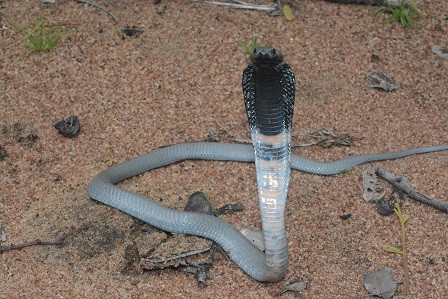
The most common spitting cobra in Africa, with Nigeria the busiest spot of all. This nightmarish creature combines the ability to spit venom 57 times in 20 minutes, with the usual venom injected rapidly during a bite. Black-necked spitting cobras measure 1.2-2.2 metres, and are a rare snake which humanity has made more common rather than less. Their natural habitat is open areas rather than forests, and with heavy deforestation progressing annually in Nigeria, they’ve moved into these open areas and begun to terrorise farmers. Forest cobras are the opposite, shunning human civilisation (and are therefore declining).
The black-necked sitting cobra aims directly for eyes. A successful hit will blind you for 3 days, causing your eyeball to go numb. Its bite isn’t to be underestimated either. Naja nigricollis has highly anticoagulant venom which cleaves directly through fibrinogen and cross-linked fibrin, the final clotting material of wounds. The venom also targets the heart. When injected into mice, swelling appeared on their heart tissue, and collagen protein fibres degraded. Their heart tissue even changed colour, from deep red to paler.
Naja nigricollis is most likely to prowl the Nigerian countryside during wet season (June-July), whereas they become more sluggish during dry season (December-February). They also eat significantly less during dry season. As younglings, their primary food source is the lizard, Agama agama. Adults graduate to birds and small, scurrying mammals.
| 2 | Smith’s African water snake |
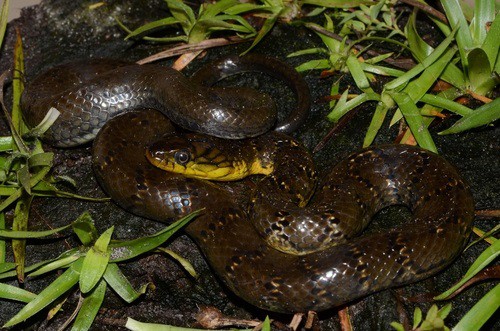
The Grayia genus of African watersnakes has 4 members, and Smith’s watersnake is easily the most common. This is a non-venomous snake of swampy forests, particularly swamps in forests of dense undergrowth, covered with shrubs and ferns. Smith’s watersnakes are semi-aquatic, and can be extremely common in certain swamps, where they prey exclusively on fish and amphibians. But you don’t have to worry about slipping and landing on your back in the mud. Smith’s watersnake wouldn’t dream of hurting anybody, and would be unable to if a murderous urge suddenly struck.
This Nigerian snake reaches a maximum of 160cm, yet is low on the food chain. Grayia smythii’s many predators include herons, scooping them out of the water with their long beaks, human fishermen, Nile monitors, and possibly forest cobras and black-necked spitting cobras.
This is a very common species, ranging from Uganda in the far east to Gambia in the far west. Smith’s watersnake lays 8-14 eggs, which are well hidden in buttress roots, buried beneath leaf litter. In a 2001 study conducted 15km from Port Harcourt, Nigeria, fish constituted 25% of their diet, and amphibians 75%. Their single top prey was the western clawed frog (Xenopus tropicalis).
| 3 | Spotted night adder |
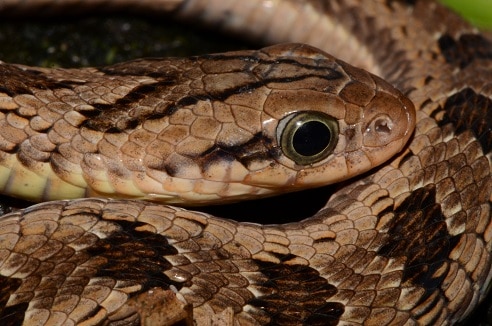
A common Nigerian snake with a moderately dangerous venom, which mainly causes swelling, fever, and pain. The spotted night adder (Causus maculatus) is one of the Africa’s most adaptive venomous snakes. They appear in a huge range of habitats, from dense rainforest to open savannahs to canyons in Ethiopia. They’re spread far and wide, from Uganda to Nigeria to Sierra Leone. They only avoid true deserts, requiring some moisture, as their main food source is amphibians.
Spotted night adders are easily recognisable. They have an olive base, overlaid with widely spaced black dots. A few are missing these black dots, but there’s little variation in colour with Causus maculatus. This is a small snake at 30-60cm, maximum 70cm, and males take part in ritualistic wrestling.
According to a 2004 study, conducted in a rainforest patch along a river shore in Nigeria’s Akwa Ibom state, spotted night adders eat 66.7% amphibians and 33.3% small mammals. Confirmed species include Hallowell’s toads, square-marked toads, and golden puddle frogs. Spotted night adders have natural resistance to heart-stopping bufotoxins produced in these toads’ slimy skins.
| 4 | Ball python |
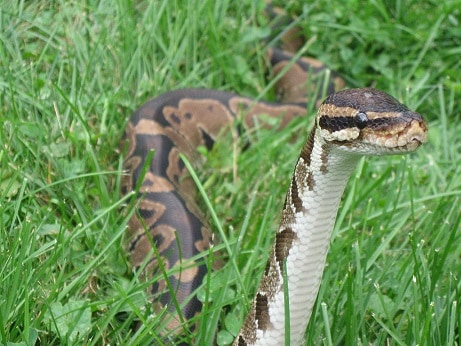
The most popular pet python worldwide. The ball python is relatively short, typically measuring 1 metre, with an all time record of 183cm. This is both the most northerly and western python worldwide, excluding invasive species. Ball pythons range from Gambia to Uganda, and Nigeria lies at the epicentre. Many Nigerians worship this python; the Igbo people build coffins and conduct funerals for ball pythons whenever they die.
Ball pythons prey on birds and mammals. Females tend to live in burrows, while males have tree-climbing tendencies. Their name originates from their famous instinct to coil into a ball when threatened by predators. It’s estimated that 100,000 ball pythons are exported from Africa annually for the pet trade.
Ball pythons lay just 10 eggs per clutch, but the eggs are relatively large at 6.0 by 4.0cm. The main purpose of their infamous ball is protecting their brains, but a 2004 study from Lomé, Togo revealed how mothers use it to protect offspring. It found that if mothers coiled around their egg clutch, the temperature was only slightly increased, but it significantly prevented evaporative water loss. Offspring of these “balled” eggs were larger, faster swimmers, more energetic, and grew more rapidly, compared to eggs that mothers didn’t coil around.
| 5 | Blanding’s catsnake |
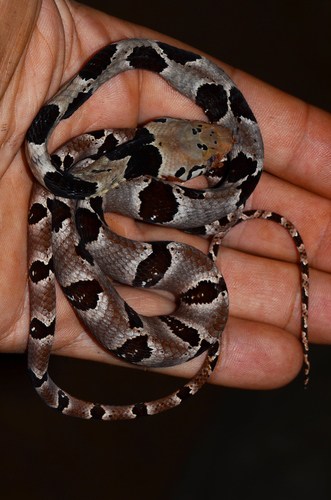
A large Nigerian snake which regularly breaks through the 2 metre barrier. This is a tree-climbing snake which is proven to reach 25 metres above ground. Blanding’s catsnake (Toxicodryas blandingii) is a nocturnal species which is active from dusk till dawn, and has a moderately dangerous venom. In one of the few cases on record, the victim suffered from cramps, random sensitiveness, and random aches and pains, and recovered within 2 days.
This Nigerian snake requires trees, but is comfortable in tree clumps directly next to human habitation, meaning that they’re not close to endangered. Its diet is varied, including dwarf chameleons and more mammals as adults, including bats such as golden short-palated fruit bats and Angolan free-tailed bats. They seem to be especially amazing climbers. In 2010, one Blanding’s catsnake managed to grab some prey caught in a large bat net, which was erected in a forest by incredibly thin wire. It must have climbed the mesh or the thin wire itself to acquire the bat, which was 2 metres above ground.
Blanding’s catsnake belongs to the same family as the powdered catsnake (T. pulverulenta), but is easily the longer of the two, reaching 2.8 metres versus 1.25 metres.
| 6 | Roman’s carpet viper |
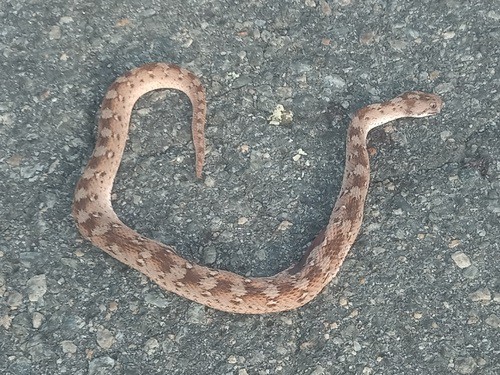
This potentially deadly venom bomb belongs to the same Echis genus as the infamous saw-scaled viper of India. Roman’s carpet viper is a very recent addition, as it was only made an official species in 2018, when it was split from the West African carpet viper. It was distinguished by an especially high count of ventral (belly) scales, with 150-168 in females, and 146-156 in males. The number of scales around the eyes was also higher.
So far, the largest known Roman’s carpet viper is a male measuring 71.5cm, found in Central African Republic. In the initial 2018 discovery study, the largest male measured 61.5cm and the largest female 55.5cm.
Roman’s carpet vipers are found mainly in central and northeast Nigeria, and while research is scarce, they deal out plenty of bites. A study on antivenom effectiveness gathered hospital data from 2021 and 2022 in Nigerian hospitals, and managed to find 5467 Echis romani victims. Its symptoms include coagulopathy, AKA blood clotting chaos, and the antivenom was indeed effective, causing a 93-94% reduction in mortality.
| 7 | Saharan sand boa |
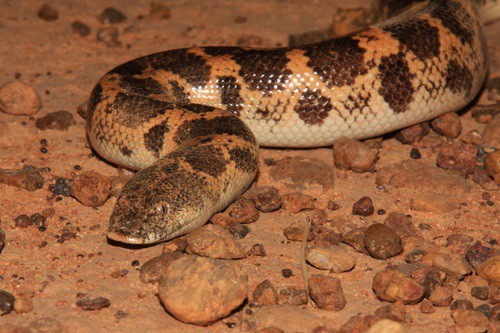
A species of drier areas, which is most common in northern Nigeria. The Saharan sand boa (Eryx muelleri) lives not in majestic sand dunes, but dry savannah. Occasionally they appear at the transition zone between desert and dry savannahs, but never within sand deserts like the Arabian sand boa.
Saharan sand boas are completely harmless and rarely exceed 80cm. Within dry savannahs, they most commonly lurk in well vegetated spots rather than bare soil, possibly for disguise, or possibly because prey is more common amid tangled bushes and dry grass. Eryx muelleri eats a mixture of lizards and mammals, shifting further towards mammals with age, as their mouths are simply too small early in life. The African five-lined skink is one confirmed reptile meal.
This species has a small presence in the international pet market. Between 2007 and 2012, 571 were exported from Togo, a fraction of the relentless conveyor belt of ball pythons. The Saharan sand boa species has virtually no variation in its appearance, being virtually identical across its central African range.
| 8 | West African carpet viper |
The other main Echis viper in Nigeria. The West African carpet viper (Echis ocellatus) was said in 2001 to account for 66% of venomous snakebites in Nigeria. Now that Roman’s carpet viper has been made an independent species, that proportion will be reduced, but it’s still perhaps western Africa’s most dangerous serpent, alongside the black-necked spitting cobra.
This snake is most common in western Nigeria, while Roman’s carpet viper inhabits the east. West African carpet vipers reach a maximum of just 65cm. There’s few neurotoxic symptoms like paralysis and respiratory failure, but Echis ocellatus doubles down on every other dark power: swelling, tissue necrosis, sudden haemorrhaging. In Ghana to the west, Echis occellatus causes 60% of snakebites, and 90% of deaths. The mortality rates of bites have been reported at 11-17%.
When preparing to attack, the West African carpet viper rubs its jagged scales together to create its signature “sawing” sound. This species derives a large portion of its diet from arthropods like scorpions, though less than the Indian saw-scaled viper. This risky diet probably explains why its venom became so lethal, compared to the spotted night adder, which doesn’t need to disable its amphibian prey as rapidly.
| 9 | Rufous-beaked snake |
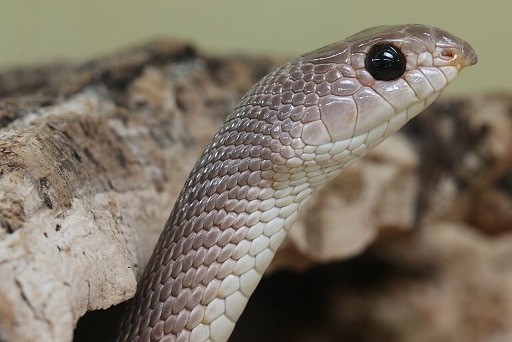
A pale, thin snake which reaches a confirmed maximum of 1.58 metres. The western rufous beaked snake is common in Nigeria and tends to inhabit dry and moist savannah, open woodlands and grasslands. Areas with bushes and thickets are a haven for this snake. They move by day, and travel relatively slowly, regularly taking shelter in termite mounds and animal burrows. Rhamphiophis oxyrhynchus has virtually no patterns, neither from a distance nor up close.
Rufous beaked snakes are rear-fanged and must chew their victim repeatedly to inject venom. One detailed report comes from a 2014 article, when a Rhamphiophis oxyrhynchus snapped down on a 24 year old man’s finger and maintained a tight grip for 20 seconds. Within 20 minutes the finger began to swell. Within hours, this covered the entire forearm, and soon the victim struggled to move his arm. But by the next day, these symptoms had faded except for a mild, generalised pain in his arm.
Rufous-beaked snake venom also contains neurotoxins, specifically the unique rufoxin, but these have yet to manifest in human beings. The only risk is the incredibly tight grip when they snap their fangs shut, and a benevolent determination not to hurt the snake by ripping its mouth off.
| 10 | Western forest file snake |
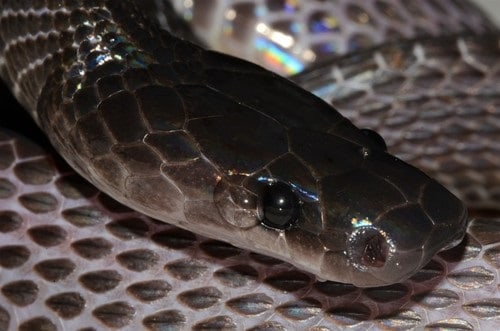
A snake of swampy rainforest which sticks to the forest floor rather than climbing trees. Mehelya is a weird family, as it has large spaces between its scales, revealing the pale skin below. Yet the individual scales are sharp and jagged, hence the “file” name. They also have a triangular shape when viewed in a cross section.
As for this species, the western forest file snake (Mehelya poensis) is common in central Africa, and Nigeria lies roughly at the epicentre of its range. Mehelya poensis eats a variety of reptiles; lizards, geckos and fellow snakes are all parts of its bewilderingly large menu, as are toads in the Bufo family.
Mehelya poensis has a bizarrely shaped snout, which is shaped like a spade. This is optimal for shifting aside loose soil. Swampy forests of Nigeria are home to a menagerie of snakes, but while Smith’s watersnakes stick to swamps themselves, this species specialises in invading burrows, shifting aside loose debris to enlarge a path. Western forest file snakes are no threat to humans, rarely biting even if picked up. This is one of 5 Mehelya filesnake species in Africa.